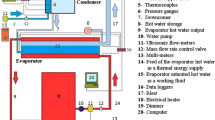Abstract
The present study reports the heat-transfer performance of a two-phase closed thermosyphon (TPCT) equipped with a novel condenser. Distillated water was used as working fluid, with a volumetric liquid filling ratio of 75 %. An increase in heat flux was used to measure the response of the TPCT, including variations in temperature distribution, thermal resistance, average temperature of each section of TPCT and overall thermal difference. Results show that for various power inputs from 71 to 960 W, the TPCT with the novel condenser had a lower wall-temperature difference between the evaporator and condenser sections than did the unmodified TPCT. Given the experimental data for heat-transfer performance, it was found that the thermal resistance in the TPCT equipped with the proposed condenser was between 10 and 17 % lower than in the one without.







Similar content being viewed by others
Abbreviations
- Cp:
-
Constant pressure specific heat (J/kg K)
- d:
-
Hydraulic diameter (m)
- I:
-
Current (A)
- L:
-
Condenser height (m)
- g:
-
Gravitational constant (m/s2)
- hfg :
-
Latent heat of vaporization (J/kg)
- m:
-
Mass flow rate (kg/s) or (g/s)
- P:
-
Pressure (Pa) or (kPa)
- R:
-
Thermal resistance (°C/W)
- Q:
-
Heat rate (W)
- T:
-
Temperature (°C)
- h:
-
The convective heat transfer coefficient (W/m2K)
- k:
-
The thermal conductivity (W/m K)
- V:
-
Voltage (V)
- υ:
-
Kinematic viscosity (m2/s)
- ρ:
-
Density (kg/m3)
- µ:
-
Dynamic viscosity (Pa s)
- η:
-
Efficiency of TPCT
- w:
-
Liquid water
- g:
-
Gas phase
- sat:
-
Saturate
References
Yau YH (2007) Application of a heat pipe heat exchanger to dehumidification enhancement in a HVAC system for tropical climates—a baseline performance characteristics study. In J Therm Sci 46:164–171
McGlen RJ, Jachuck R, Lin S (2004) Integrated thermal management techniques for high power electronic devices. Appl Therm Eng 24(8–9):1143–1156
Solomon AB, Mathew A, Ramachandran K, Pillai BC, Karthikeyan VK (2013) Thermal performance of anodized two phase closed thermosyphon (TPCT). Exp Therm Fluid Sci 48:49–57
Khodabandeh R, Palm B (2002) Influence of system pressure on the boiling heat transfer coefficient in a closed two-phase thermosyphon loop. Int J Therm Sci 41:619–624
Alizadehdakhel A, Rahimi M, Alsairafi AA (2010) CFD modeling of flow and heat transfer in a thermosyphon. Int Commun Heat Mass Transf 37(3):312–318
Jiao B, Qiu LM, Zhang XB, Zhang Y (2008) Investigation on the effect of filling ratio on the steady-state heat transfer performance of a vertical two-phase closed thermosyphon. Appl Therm Eng 28(11–12):1417–1426
Hussein HMS, El-Ghetany HH, Nada SA (2006) Performance of wickless heat pipe flat plate solar collectors having different pipes cross sections geometries and filling ratios. Energy Convers Manag 47(11–12):1539–1549
Farsi H, Jolya JL, Miscevica M, Platela V, Mazetb N (2003) An experimental and theoretical investigation of the transient behavior of a two-phase closed thermosyphon. Appl Therm Eng 23(15):1895–1912
Huminic G, Huminic A (2011) Heat transfer characteristics of a two-phase closed thermosyphons using nanofluids. Exp Thermal Fluid Sci 35(3):550–557
Parametthanuwat T, Rittidech S, Pattiya A (2010) A correlation to predict heat-transfer rates of a two-phase closed thermosyphon (TPCT) using silver nanofluid at normal operating conditions. Int J Heat Mass Transf 53(21–22):4960–4965
Noie SH (2005) Heat transfer characteristics of a two-phase closed thermosyphon. Appl Therm Eng 25(4):495–506
Ong KS, Haider-E-Alahi M (2003) Performance of a R-134a-filled thermosyphon. Appl Therm Eng 23(18):2373–2381
Liu S, Li J, Chen Q (2007) Visualization of flow pattern in thermosyphon by ECT. Flow Meas Instrum 18(5–6):216–222
Chen YJ, Wang PY, Liu ZH (2013) Application of water-based SiO2 functionalized nanofluid in a loop thermosyphon. Int J Heat Mass Transf 56(1–2):59–68
Payakaruk T, Terdtoon P, Ritthidech S (2000) Correlations to predict heat transfer characteristics of an inclined closed two-phase thermosyphon at normal operating conditions. Appl Therm Eng 20(9):781–790
Yang XF, Liu ZH (2012) Flow boiling heat transfer in the evaporator of a loop thermosyphon operating with CuO based aqueous nanofluid. Int J Heat Mass Transf 55(25–26):7375–7384
Buschmann MH (2013) Nanofluids in thermosyphons and heat pipes: overview of recent experiments and modelling approaches. Int J Therm Sci 72:1–17
Leong KY, Saidur R, Mahlia TMI, Yau YH (2012) Performance investigation of nanofluids as working fluid in a thermosyphon air preheater. Int Commun Heat Mass Transf 39(4):523–529
Khandekar S, Joshi YM, Mehta B (2008) Thermal performance of closed two-phase thermosyphon using nanofluids. Int J Therm Sci 47:659–667
Amatachaya P, Srimuang W (2010) Comparative heat transfer characteristics of a flat two-phase closed thermosyphon (FTPCT) and a conventional two-phase closed thermosyphon (CTPCT). Int Commun Heat Mass Transf 37(3):293–298
Khodabandeh R, Furberg R (2010) Heat transfer, flow regime and instability of a nano- and micro-porous structure evaporator in a two-phase thermosyphon loop. Int J Therm Sci 49:1183–1192
Rahimi M, Asgary K, Jesri S (2010) Thermal characteristics of a resurfaced condenser and evaporator closed two-phase thermosyphon. Int Commun Heat Mass Transf 37(6):703–710
Han K, Cho DH (2005) A comparison of the heat transfer performance of thermosyphon using a straight groove and a helical groove. J Mech Sci Technol 19(12):2296–2302
Ma HB, Peterson GP (1996) Experimental Investigation of the maximum heat transport in triangular grooves. J Heat Transf 118(3):740–746
Zhang M, Liu Z, Ma G (2008) The experimental investigation on thermal performance of a flat two-phase thermosyphon. Int J Therm Sci 47(9):1195–1203
Wang J (2009) Experimental investigation of the transient thermal performance of a bent heat pipe with grooved surface. Appl Energy 86(10):2030–2037
Holman JD (2012) Experimental methods for engineers, 8th edn. McGrow-Hill, New York
Collier JG, Thome JR (1996) Convective boiling and condensation, 3rd edn. Oxford University Press, Oxford
Author information
Authors and Affiliations
Corresponding author
Rights and permissions
About this article
Cite this article
Aghel, B., Rahimi, M. & Almasi, S. Heat-transfer enhancement of two-phase closed thermosyphon using a novel cross-flow condenser. Heat Mass Transfer 53, 765–773 (2017). https://doi.org/10.1007/s00231-016-1858-6
Received:
Accepted:
Published:
Issue Date:
DOI: https://doi.org/10.1007/s00231-016-1858-6




